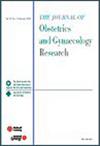Transvaginal mesh surgery for pelvic organ prolapse without blind maneuver: Follow-up of 1 year or longer
Abstract
Aim
To present surgical outcomes of transvaginal mesh surgery for pelvic organ prolapse (POP) without the blind maneuver, followed up 1 year or more.
Methods
This retrospective study included 140 consecutive women with a mean age of 77.6 years. We investigated surgical outcomes, including early and late complications and recurrence. Furthermore, we studied risk factors for recurrence and mesh extrusion using uni- and multivariate analyses.
Results
Surgery required 120 ± 21 min, with blood loss of 58 ± 63 g. Minor injuries of the bladder and rectum occurred in six and two patients, respectively. The urethral catheter was removed on postoperative day 1.2, and patients were discharged on postoperative day 4. There was no case of voiding dysfunction requiring catheterization. Wound infections occurred in four patients; but they subsided with only peroral antibiotics. Twenty-five patients had anatomical recurrences; of those, nine underwent additional surgery. Mesh extrusion occurred in six patients; the extruded part was excised in all patients. Eleven patients underwent transvaginal tape surgery for subsequent stress urinary incontinence. Logistic regression analyses indicated that risk factors for recurrence were prolapse stage and uterine status, and that for mesh extrusion was uterine status.
Conclusions
Although recurrence and mesh-related problems could occur especially in patients with a higher stage of prolapse and/or a history of hysterectomy, it is considered that our technique is safe and effective to treat women with POP. However, we need to identify other, more appropriate techniques for patients with severe prolapse and/or a history of hysterectomy.





 求助内容:
求助内容: 应助结果提醒方式:
应助结果提醒方式:


